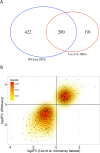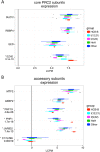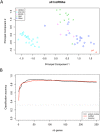Specific expression of novel long non-coding RNAs in high-hyperdiploid childhood acute lymphoblastic leukemia
- PMID: 28346506
- PMCID: PMC5367703
- DOI: 10.1371/journal.pone.0174124
Specific expression of novel long non-coding RNAs in high-hyperdiploid childhood acute lymphoblastic leukemia
Abstract
Pre-B cell childhood acute lymphoblastic leukemia (pre-B cALL) is a heterogeneous disease involving many subtypes typically stratified using a combination of cytogenetic and molecular-based assays. These methods, although widely used, rely on the presence of known chromosomal translocations, which is a limiting factor. There is therefore a need for robust, sensitive, and specific molecular biomarkers unaffected by such limitations that would allow better risk stratification and consequently better clinical outcome. In this study we performed a transcriptome analysis of 56 pre-B cALL patients to identify expression signatures in different subtypes. In both protein-coding and long non-coding RNAs (lncRNA), we identified subtype-specific gene signatures distinguishing pre-B cALL subtypes, particularly in t(12;21) and hyperdiploid cases. The genes up-regulated in pre-B cALL subtypes were enriched in bivalent chromatin marks in their promoters. LncRNAs is a new and under-studied class of transcripts. The subtype-specific nature of lncRNAs suggests they may be suitable clinical biomarkers to guide risk stratification and targeted therapies in pre-B cALL patients.
Conflict of interest statement
Figures









Similar articles
-
Non-Coding RNA Signatures of B-Cell Acute Lymphoblastic Leukemia.Int J Mol Sci. 2021 Mar 7;22(5):2683. doi: 10.3390/ijms22052683. Int J Mol Sci. 2021. PMID: 33799946 Free PMC article. Review.
-
Very long intergenic non-coding RNA transcripts and expression profiles are associated to specific childhood acute lymphoblastic leukemia subtypes.PLoS One. 2018 Nov 15;13(11):e0207250. doi: 10.1371/journal.pone.0207250. eCollection 2018. PLoS One. 2018. PMID: 30440012 Free PMC article.
-
A childhood acute lymphoblastic leukemia-specific lncRNA implicated in prednisolone resistance, cell proliferation, and migration.Oncotarget. 2017 Jan 31;8(5):7477-7488. doi: 10.18632/oncotarget.13936. Oncotarget. 2017. PMID: 27980230 Free PMC article.
-
Unique long non-coding RNA expression signature in ETV6/RUNX1-driven B-cell precursor acute lymphoblastic leukemia.Oncotarget. 2016 Nov 8;7(45):73769-73780. doi: 10.18632/oncotarget.12063. Oncotarget. 2016. PMID: 27650541 Free PMC article.
-
Myeloproliferative neoplasms with t(8;22)(p11.2;q11.2)/BCR-FGFR1: a meta-analysis of 20 cases shows cytogenetic progression with B-lymphoid blast phase.Hum Pathol. 2017 Jul;65:147-156. doi: 10.1016/j.humpath.2017.05.008. Epub 2017 May 24. Hum Pathol. 2017. PMID: 28551329 Review.
Cited by
-
Identification of a Seven-lncRNA-mRNA Signature for Recurrence and Prognostic Prediction in Relapsed Acute Lymphoblastic Leukemia Based on WGCNA and LASSO Analyses.Anal Cell Pathol (Amst). 2021 Jun 9;2021:6692022. doi: 10.1155/2021/6692022. eCollection 2021. Anal Cell Pathol (Amst). 2021. PMID: 34211824 Free PMC article.
-
Long Non-Coding RNA and Acute Leukemia.Int J Mol Sci. 2019 Feb 9;20(3):735. doi: 10.3390/ijms20030735. Int J Mol Sci. 2019. PMID: 30744139 Free PMC article. Review.
-
Non-Coding RNA Signatures of B-Cell Acute Lymphoblastic Leukemia.Int J Mol Sci. 2021 Mar 7;22(5):2683. doi: 10.3390/ijms22052683. Int J Mol Sci. 2021. PMID: 33799946 Free PMC article. Review.
-
The lncRNA TEX41 is upregulated in pediatric B-Cells Acute Lymphoblastic Leukemia and it is necessary for leukemic cell growth.Biomark Res. 2021 Jul 7;9(1):54. doi: 10.1186/s40364-021-00307-7. Biomark Res. 2021. PMID: 34233751 Free PMC article.
-
Drug Resistance Biomarkers and Their Clinical Applications in Childhood Acute Lymphoblastic Leukemia.Front Oncol. 2020 Jan 17;9:1496. doi: 10.3389/fonc.2019.01496. eCollection 2019. Front Oncol. 2020. PMID: 32010613 Free PMC article. Review.
References
-
- Kaneko Y, Hayashi Y, Sakurai M (1981) Chromosomal findings and their correlation to prognosis in acute lymphocytic leukemia. Cancer Genet Cytogenet 4: 227–235. - PubMed
MeSH terms
Substances
LinkOut - more resources
Full Text Sources
Other Literature Sources
Molecular Biology Databases
Miscellaneous

